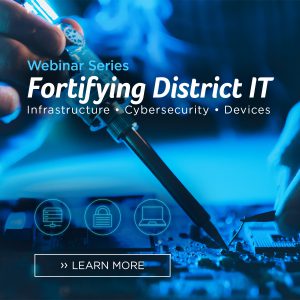 Districts expect more responsiveness and reliability from IT service and support providers.
Districts expect more responsiveness and reliability from IT service and support providers.
K–12 districts used to take it for granted that they would need to deal with many different vendors—one for their network infrastructure, another for sourcing or upgrading computers, and others for printers and copiers.
Now that they know there are companies who effectively handle all of these things in one package, they’ve begun to expect better service levels and features like alerting and reporting, just-in-time consumables, and strategic planning.
More and more, districts want a consultant-type relationship with a service provider. Infrastructure is becoming increasingly complex, and so is cybersecurity. As educators become comfortable with shifting applications and services to the cloud, they expect provider partners who will help them work through these complexities, while looking at the district and its learning environments as a whole.
Districts need support for in-house IT teams, and they want turnkey solutions to “free” their resources.
When it comes to supporting existing IT teams or looking for turnkey service and support offerings, districts want “all of the above.” Adding headcount for district or school IT staff can be challenging, but IT needs don’t diminish just because you can’t add staff.
We have always delivered our IT solutions as a mix of remote and onsite service depending on district requirements. Our systems for monitoring, reporting, and making recommendations to clients have evolved over the past four decades. While Scantron has always provided initial environmental assessments, periodic analysis, and strategic plans, our clients have begun to depend on periodic reports and ask for more detailed insights.
Because a district’s IT strategy is so often a part of its ability to support educators and students, administration needs to free in-house talent to focus on new projects, new features, and experimentation with new technologies. That motivation—to make better use of IT talent—has helped drive our service and support model: we team up with district in-house IT resource(s) to identify and take the day-to-day activities off their shoulders, find and close any security and support exposures, and serve as a team expansion.
More districts are willing to move to a “hybrid cloud” environment, where they have a mix of on-premise and hosted applications, so they need a versatile support model that accommodates both. When we can help a district IT team (or a very stressed senior administrator) stay on top of things, we tend to keep that client for a long time.
Scantron helps customers adapt to forces of change: innovation, regulation, labor, competition, and more.
We continuously evaluate new vendors and new technologies so that our clients never need to wonder if they’re working with the latest (and most reliable) platforms and services. We’re developing Infrastructure as a Service, Device as a Service, Managed Security Service, and packaged IT offerings like affianceSUITE EDU, a managed IT offering designed especially for small and medium districts to help smooth out the peaks and valleys of district IT operation.
Skilled labor shortages play to our strengths. It’s much easier for us to recruit, train, and retain one highly skilled IT administrator who can service multiple district than it is for those multiple districts to each do so. Another factor is regulation. Increased data privacy regulations also play to our strengths. We can stay abreast of regs, then scale up, train, and rapidly enact consistent policies in ways that our clients may not be able to.
The best part about change is the benefit of scale: when we discover a technology improvement, new efficiency, or best practice in one district, we can apply it quickly for other districts. Often, clients don’t have to take any action at all.
As IT service matures, the industry is responding to growing expectations of reporting and recommendations. Since businesses have access to increasing amounts of data, the service providers who win are those who can show districts how to make sense of information—in our case, risk analysis, performance data, and cybersecurity issues—and respond to it.


Social
View our latest posts or connect with us below on Social Media.